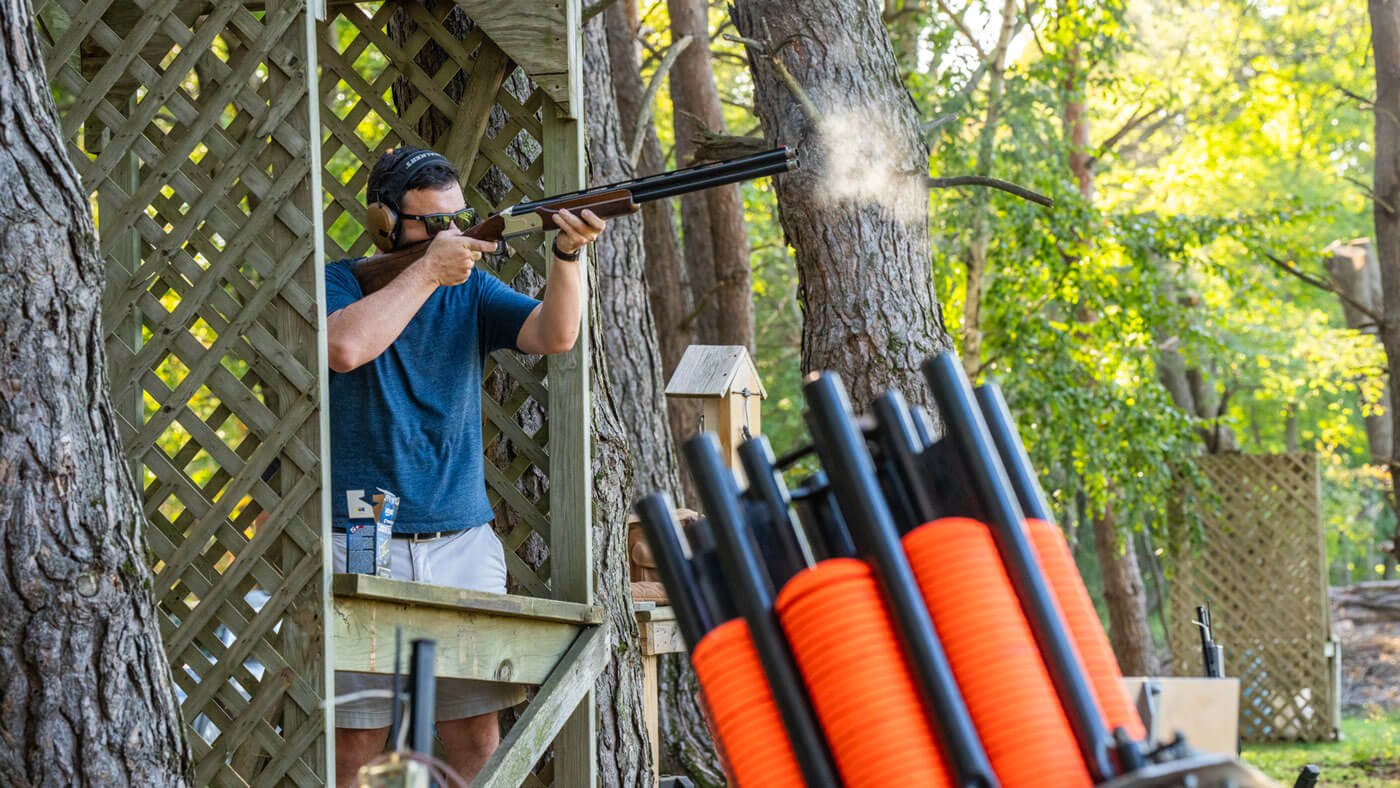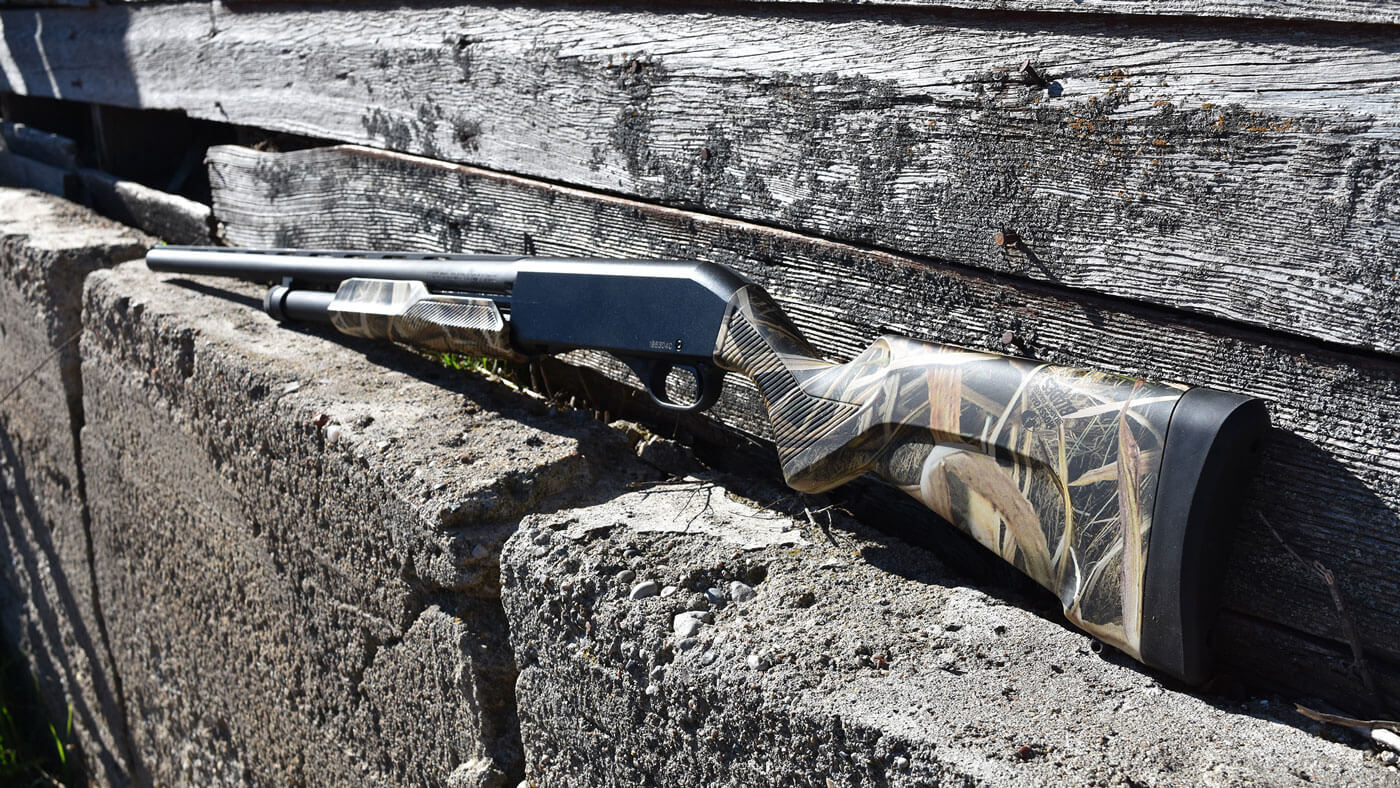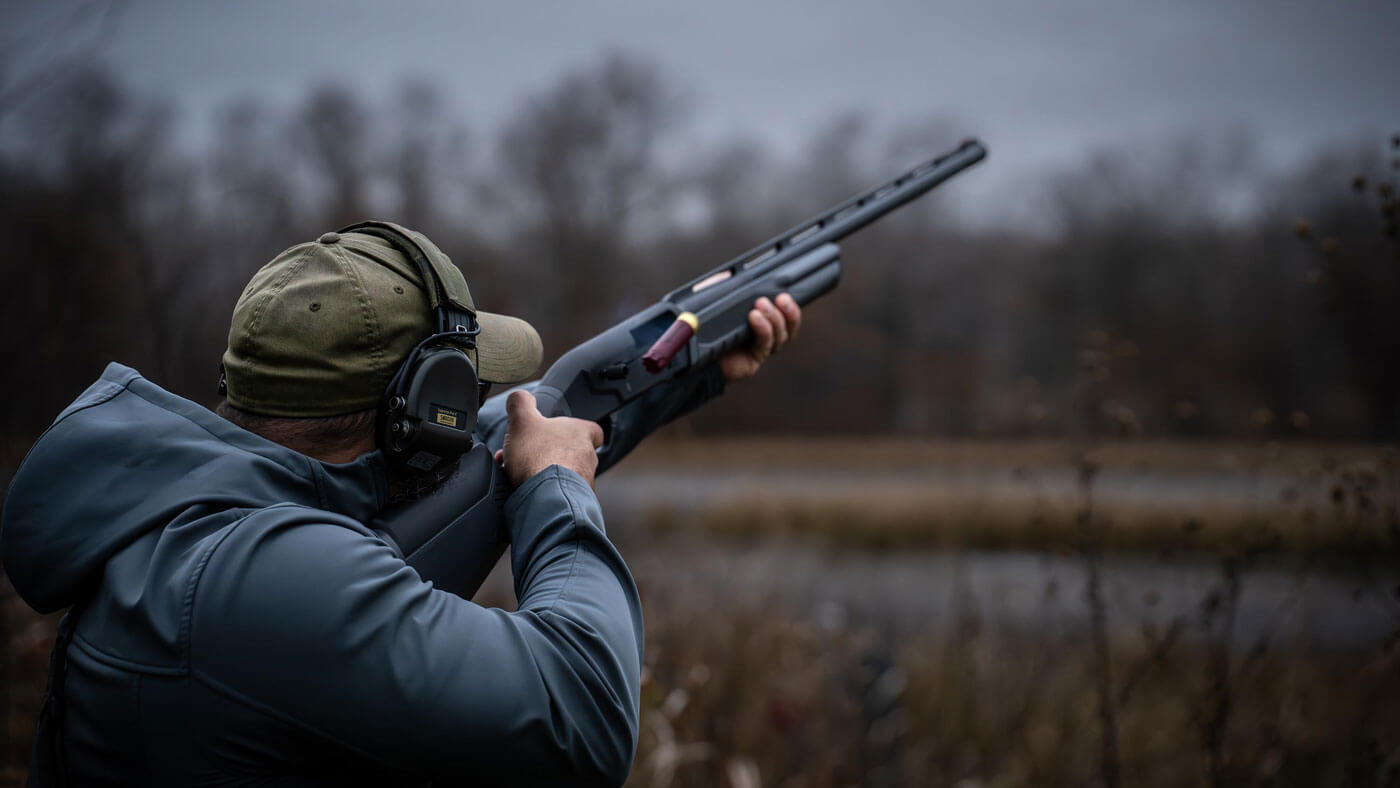- Savage Blog
- Basics of Five Stand Clay Shooting
Basics of Five Stand Clay Shooting

A combination of three of the most popular shotgun games today, five stand clay shooting is a unique shotgun sport that draws from trap, skeet, and sporting clays. It is a unique challenge that serves up a variety of different target types that are great for practicing both shooting skills and hunting scenarios. Learning the basics of five stand can help make you a better all-around shotgun shooter, and help improve your performance in the field for a variety of different types of bird hunting. So let’s dive into the basics of five stand and see what you need to know when it comes to this unique and interesting shotgun game!
Rules and field layout
A five stand field lays out very similarly to a trap field, with five shooting stations set up in a line or slight arc. Trap throwers are laid out in a random assortment of positions across the field, and there can be anywhere from a few trap throwers to over a dozen set up to throw a variety of different sized targets at different angles and speeds. Five stand fields are often set up within a skeet or trap range as well in order to take advantage of the trap house thrower, and the throwers within the high and low skeet houses to add more target variety.
Due to the large variety and angles of the targets that can be presented, the stations for five stand will have frames set up much like those in sporting clays. This is to limit the shooters’ movement within the stations and to ensure that the range stays safe and doesn’t allow for shooters to swing their shotguns too far while engaging a target. Like sporting clays, each station will have a “menu card” that details which thrower the targets will come from, how many targets there will be, and whether targets are thrown as a single, true pair, or report pair.
Now that you have an idea of the layout of a typical five stand field, here are some of the rules you will need to know when you are learning the basics of five stand:
Shooters will shoot in squads of up to five members
Stations will include a single target and two pairs of targets for their course of fire. The targets can either be true pairs or report pairs.
A “true pair” will throw two targets at the same time.
A “report pair” will throw the first target, then the second target will be thrown after you shoot the first target.
Each shooter will shoot their five targets at their station, then rotate to the next station after the last shooter has completed their targets.
To call for a target, the shooter yells “Pull”, after which the target will be thrown from the designated trap thrower.
If the target comes out of the trap thrower broken, the scorekeeper will call “no target”, and the shooter will be able to repeat the throw.
If a target is broken by the shot, it will be called a “hit”.
If you miss the target with your shot, it will be called either “miss” or “lost”.
In order for a target to be considered broken or “hit”, a physical piece must be broken off. A target that has dust come off it but does not break is considered a missed target.
Each round will consist of 25 total targets shot. In a typical match, there may be one or two rounds shots for a total of 25 to 50 targets.
Targets thrown can include standard size both standard size and mini targets that are thrown in the air and on the ground.

If you are looking for a place to practice and learn the basics of five stand, there are plenty available! Many trap, skeet, and sporting clays organizations have sanctioned five stand matches that you can shoot in and learn more about the sport. Many ranges will also offer five stand courses in addition to their regular shotgun games, since five stand is easy to set up within a trap or skeet field. Here are some organizations you can join to learn more about shooting five stand:
There are also many state and local level shooting clubs that you can join to learn more about five stand and other shotgun games!
Shooting equipment
When learning about the basics of five stand, you will find that you don’t need much equipment to get started. In fact, all you really need is some ear protection, eye protection, and a trap bag or pouch to hold your shotgun shells. With these basic pieces of equipment, anyone can get started in five stand shooting!
Eye and ear protection are the most important and basic pieces of equipment needed for any shooting sports activity. Most shotgun shooters will opt to use ear plugs or slim earmuffs for their hearing protection. This is because holding your head on the stock is critical for accurate shotgun shooting, and bulky ear muffs may not allow you to fully rest your head on the stock.
The trap bag is usually attached to a belt that goes around your waist. Most trap bags come with two or three separate pouches to hold shotshell boxes, empty shotshells, and tools such as chokes or choke wrenches. One tip that can help you remember how soon until you rotate stations is to keep your shotgun shells in the box in the trap bag. The shotshells are stacked in rows of five within the box, so as you pull shells from the box while you are shooting you will have a visual reminder of how many targets you have remaining until rotating to the next station.

Shotgun selection
Aside from safety equipment, the shotgun you select is one of the most important decisions you will make when you are learning the basics of five stand. There are two important parts of a shotgun to consider: the gauge and the action type. The gauge of shotgun you use ultimately comes down to personal preference. The larger the gauge (lower the number, i.e. 12 gauge is larger than 20 gauge), the more bbs there will be in each shotshell and the denser the pattern will be. This will result in a higher chance of a hit target. However, larger shotgun gauges will also have more recoil. This is why sub-gauge options such as the 20 gauge are also very popular options among youth and recoil-sensitive shooters for their balance of performance and recoil. The action of the shotgun you use will also come down to personal preference, with each having its own advantages and disadvantages. There are three main shotgun actions that are used for shotgun shooting. These are the pump-action, the semi-automatic, and the break-action.
Pump-Action
Pump-action shotguns are good for new and novice shooters as they are common, relatively inexpensive, and easy to learn and operate. The shell is loaded and unloaded by pumping the slide of the shotgun, and this is entirely controlled by the shooter. Five stand shooting is similar to skeet and sporting clays in that speed is a factor when shooting doubles. For this reason, a pump action shotgun may not necessarily be the best choice if you’re looking for a shotgun that will provide you with the speed you need to quickly engage simultaneous or follow-up targets. However, if you’re just looking for a shotgun to learn how to shoot the basics of five stand, the Model 320 Field Grade shotgun is a reliable pump-action option that is affordable for new shotgun shooters who are just starting out.

Semi-Automatic
Semi-automatic shotguns operate like other semi-automatic firearms, where the shotshell is ejected automatically and a new shell is loaded after each shot, if the magazine is loaded. Semi-automatic shotguns are also beneficial in five stand due to the ability to quickly engage targets without having to manually operate the action. Semi-auto shotguns can also help manage recoil The Savage Renegauge is an excellent choice for five stand shooters who are looking for a semi-automatic shotgun that is reliable, easy shooting, and adjustable to nearly every shooter. For those who are looking for a budget semi-automatic shotgun that will be a workhorse on the range and while hunting, the Model 560 is also a great option.

Break-Action
Break-action shotguns are fairly popular with shotgun shooters. Most break-action shotguns come as double-barrel shotguns, with two barrels either stacked on top of each other or side by side. This allows the shooter to have two shells loaded simultaneously, which is perfect for the rapid follow-up shots typically taken in five stand. Many shotgun shooters also prefer break-action shotguns for being lightweight and ergonomic, as well as regarded for their simple design, ease of use, and their mechanical reliability. Savage offers several different break-action shotguns in the Model 555 shotgun line, including a 555 E model with automatic ejectors, a 555 Compact model for youth and smaller shooters, and a 555 Sporting model with over/under barrels and an adjustable cheek comb.

Ammunition and choke tubes
The ammunition used for five stand shooting is the most commonly available shotgun ammunition today. This ammunition is typically referred to as “game loads”, “target loads”, “field loads”, or something similar. These loads are typically lead shot, and will usually have a picture of a clay target or a small game animal such as a dove or rabbit on the box. They will also usually say “Game Load”, “Field Load”, “Target Load”, or something similar on the box. Most target loads will have specifications similar to the following:
⅞ to 1 ⅛ oz. of shot
2 ¾ inch shell length
#7 ½ or #8 shot size
1150 to 1350 fps
If you find ammunition with similar specifications to those that are outlined above, then it will be great to use for five stand shooting!

Choke tubes are important for getting the proper pattern size when shooting five stand. If your pattern is too big, then there may be holes in the pattern where the target can sneak through and not be hit by any bbs. If your pattern is too small, then you will miss the target entirely. The ideal shotgun pattern is wide enough to allow some margin for error, but small enough to be consistently dense and not allow any gaps in the pattern.
The most difficult part about selecting a choke for five stand shooting is the variety of different distances and angles that you will be shooting targets from. Your target selection may include clays that are flying slowly away from you at farther distances, or ones that are flying fast at your and in close. Using a choke that is too narrow, like a full choke, may help with longer range targets but hurt you with close in targets. The opposite is true for more open chokes like cylinder or skeet chokes. Because of this, a good middle ground for five stand is to use a choke like a modified or improved cylinder choke. These chokes often provide a good in-between pattern that can perform adequately for targets that are in close or farther away. Another strategy that is especially useful with double barrel shotguns is to use a tighter choke in one barrel for long range targets and a more open choke in the other barrel for short range targets to get the best of both worlds. To learn more about the different kinds of choke tubes and how they affect your shooting, check out this choke tube blog.

Shooting tips
Learning the basics of five stand is about more than the rules and proper equipment. Learning eye dominance, proper shooting form and stance, and proper shooting technique are also important to know as you are starting out. Here are some tips to keep in mind as you get started with the basics of five stand:
Eye dominance
Eye dominance is one of the fundamental basics of shotgun shooting that you should learn when you are first starting out. Your dominant eye is the eye that will naturally “take over” whenever you are following the target. It also determines whether you should shoot left-handed or right-handed, since shooting right-handed as a right-eye dominant shooter will allow that eye to be looking down the barrel and aiming properly at the target, allowing you to more naturally lead your shot when trying to hit the target. Most of the time, your dominant eye will correspond with your dominant hand that you use to write with. However, this is not always the case. If you don’t know which eye is your dominant eye, check out this blog post on determining eye dominance.
Stance and technique
Proper shooting stance and technique can help you get a headstart on becoming a proficient five stand shooter. When you are standing at your shooting station, familiarize yourself with which trap throwers the targets will be coming from. See if you can visualize how the targets will leave the thrower, and pay close attention when others are shooting that station to see how the targets are thrown. How the targets are laid out will determine your stance. If the target is moving very little, or going straight away from you, you can take more of a closed trapshooting stance with your feet shoulder width apart and square to the thrower. If the targets will be moving quickly and across your body, you may want to open up your stance like you would if you were skeet shooting to ensure you can swing your body easily and comfortably. No matter how you change up your stance, make sure you keep your knees bent slightly and lean forward to help absorb recoil and give you a more stable platform to shoot from.
Shotgun shooting differs greatly from how you may shoot a rifle or a handgun. In shotgun sports like five stand, you are focusing on hitting a moving target, rather than aiming at one specific point on a target. Because of this, your shooting technique will differ from normal rifle shooting technique. When you are shotgun shooting, you are not aiming the shotgun, you are following the leading edge of the target with your eyes. It is important to keep both eyes open in order to fully see the field, and to be able to see the bead of your shotgun and the target simultaneously. As you follow the target with your eyes, your arms and shotgun should naturally follow where you are looking. You should swing your shotgun ahead of the target. Your lead will depend on the speed and distance of the target, with targets closer and faster requiring more lead and targets that are slower and farther away requiring less lead. Pull the trigger as you are swinging through and leading the target with your shotgun bead to break the target.

Five stand shooting is an excellent introduction into both recreational shotgun sports and bird hunting. The basics of five stand may seem difficult to master at first, but it shares many common aspects with other shotgun games that you may be familiar with. Whether you’re looking to just have some fun on the weekends, get more into competitive shooting, or practice for the upcoming hunting season, five stand offers many options for you to enjoy! If you’re looking to get into a new shooting sports discipline and expand your horizons as a shooter, make sure you grab your shotgun and give five stand a try!

